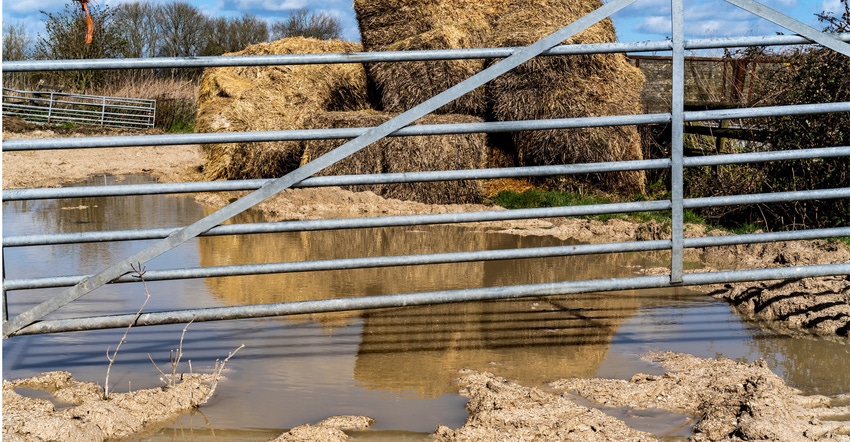June 21, 2019

With the abundance of rain Oklahoma has received over the last several weeks, farmers and ranchers around the state are likely dealing with moldy hay and spoiled feed.
Moldy or spoiled feed can present a health risk for a multitude of species, said Kris Hiney, Oklahoma State University Cooperative Extension equine specialist.
See, Deadline looming for commercial livestock producers to file with FSA
Hay can be unfit for livestock due to excessive moisture while baling or exposure to the elements, such as excessive rain or flooding. Molds present in the feed may contain mycotoxins, which can cause significant health issues,” Hiney said. “While only some molds produce mycotoxins, these are visually unable to be differentiated, and the presence of mycotoxins is difficult to assess.”
Animals that consume contaminated feeds can experience liver and kidney damage, neurologic disorders and estrogenic effects. While mycotoxins may not always cause clinical diseases, they can interact with animal stressors to decrease efficiency and reproduction and increase disease incidence, which may not be directly attributable by the producer to the feedstuff.
See, Cattle producers should examine animals for signs of foot rot
Adverse weather conditions during or post baling can allow mold growth, as it grows and thrives in warm and wet conditions. Hay with 14 to 15 percent moisture is subject to mold. Humidity, along with prematurely baling or excessive rain and flooding events can promote mold growth.
Hiney said it is important for producers of all forage consuming species, including cattle, sheep, goats and horses, to carefully monitor animal performance when weather conditions have increased the likelihood of spoiled or moldy forage.
“While mycotoxins typically are associated with grains, forage also can contain disease-causing agents,” she said. “Ochratoxin is typically associated with only death in young calves, as it’s rapidly degraded in the rumen in more mature animals. However, this mycotoxin has been associated with cattle deaths and abortions believed to be due to disruption phenylalanine metabolism.”
A fumigatus is a mycotoxin found more frequently in hay. Animals that consume hay containing this mycotoxin will exhibit symptoms similar to those of protein deficiencies or malnutrition, including poor haircoat, immunodeficiency and poor performance. Animals already stressed by environmental conditions may experience suppressed immune systems if they consume contaminated hay.
See, Cattle producers warned to watch for blackleg, anthrax
iney said producers must look beyond harvest forages because pastures also are susceptible to mycotoxins.
“Unfortunately, mycotoxins are not easily verified, as their distribution in feed may be highly variable,” she said. “Samples must be handled carefully prior to analysis. Visual appraisal may not be useful for producers and the use of black lights is not encouraged as a detection methodology.”
Producers concerned with the presence of mycotoxins or mold spores can send samples to a diagnostic lab. Dairy One laboratory can perform mold and yeast counts, as well as a mycotoxin panel, for a fee.
If the presence of mycotoxins is unable to be verified, producers should carefully monitor herd health regarding reproductive efficiency, feed utilization and gain, and overall health status. Keep in mind even if mycotoxins are not present, the presence of mold can decrease the digestibility of feeds and result in nutrient loss. Hiney said cattle may experience a reduction of 5 percent in ability to extract energy. The overall nutrient composition of the diet may need to be increased in compensation.
See, ELAP may offset grazing losses incurred by floodwaters
“Horse owners should be more vigilant when feeding moldy hay compared to cattle, sheep and goats. Ruminants may be better protected against mycotoxins due to degradation in the rumen. However, chronic exposure in the ruminant can be deleterious and may depend on other dietary factors,” she said.
Alternative forage sources should be investigated, if possible. If moderately moldy hay must be fed, consider having it tested for nutrient content. Spoilage may be sufficient enough to be detected through traditional forage testing. Hiney said it is important to feed in a very well-ventilated area or steam the hay, if possible.
“This is especially true for horses that typically are fed in more confined areas such as stalls and barns. Mold spores and dust can cause significant respiratory disorders to both the animals and the humans handling the feed,” she said. “More importantly, moldy forage may decrease intake due to its palatability, further reducing performance efficiency. Don’t force animals to consume hay by withholding alternative feed stuffs.”
See, Oklahoma faces devastating losses from flooding
Source: is OSU, which is solely responsible for the information provided and is wholly owned by the source. Informa Business Media and all its subsidiaries are not responsible for any of the content contained in this information asset.
You May Also Like




